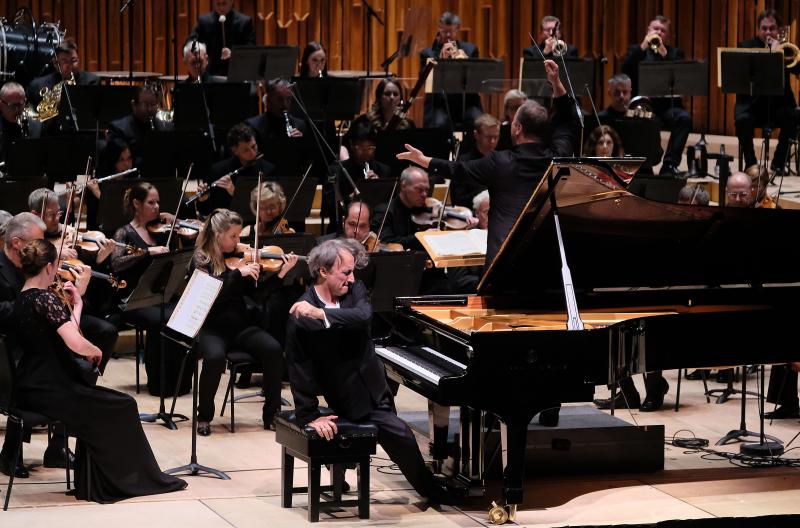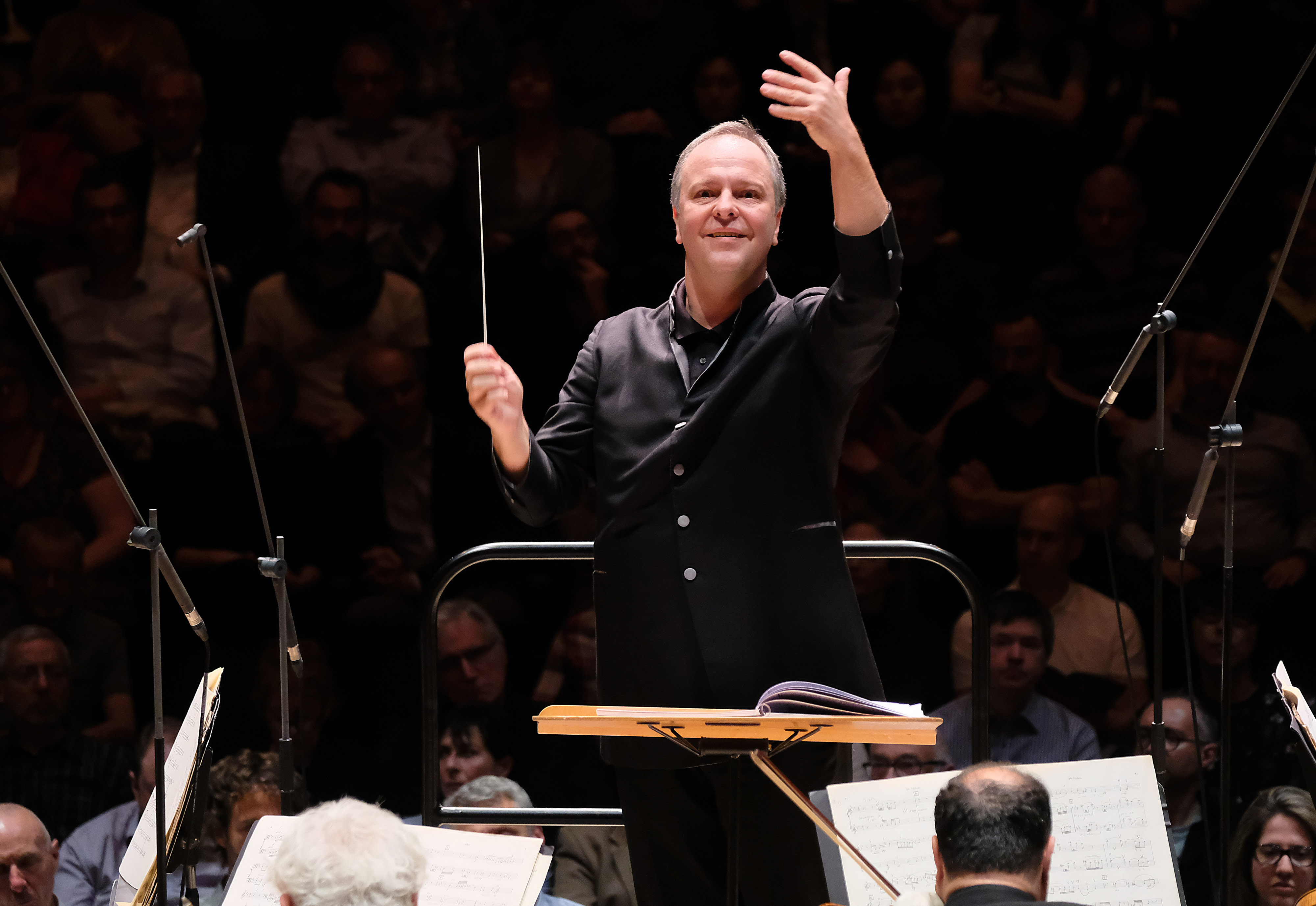Bavouzet, BBCSO, Oramo, Barbican review - playing the long game in Sibelius | reviews, news & interviews
Bavouzet, BBCSO, Oramo, Barbican review - playing the long game in Sibelius
Bavouzet, BBCSO, Oramo, Barbican review - playing the long game in Sibelius
Purpose and restraint pay off in contrasting three-movement symphonies

Perhaps Sibelius did the right thing, signing off Tapiola in 1926 and then all but closing his account, spending the next three decades sitting and drinking.
Dating from the year before his death in 1958, the Second Symphony is Schmitt’s last major work. It's cast like Sibelius’s Third in three movements, but there the resemblance ends. Schmitt tears up the symphonic rulebook and leaves the pieces to rain down like fluorescent confetti. With the experience last year of performing Schmitt’s over-ripe incidental music for Antony and Cleopatra, Sakari Oramo and the BBC Symphony Orchestra have this busy, tricksy idiom under their belts.
Oramo dug out the symphony's opening with vernal promise and determination
Their performance was a model of clarity and breezily good-natured character compared with the only commercial recording, but the symphony itself – maybe even the title is a wind-up? Schmitt didn’t write a First – is like a film-set full of actors milling around, waiting for a director to give them something to do. Vibraphone smoke drifts off a viola Gauloises. The second movement is capped with a muted trumpet, just in case the image of Belmondo fixing the middle distance with resolute ennui wasn’t already lodged in the mind’s eye.
Jean-Efflam Bavouzet reversed that strain of expression with an air of relaxed purpose in the Symphonic Variations of César Franck. Space and gesture were judged as finely from the outset as any Truffaut tracking shot to establish a contention between soloist and orchestra, expanding on the Orpheus-and-the-Furies model established by Beethoven in the Largo of the Fourth Concerto. Bavouzet drew from the lower reaches of the house Steinway an unusually open, speaking tone. If heroic assertion was missing, he supplied it with a vengeance after the interval, imperiously dismissing a rather prosaic orchestral introduction to the Left-Hand Concerto of Ravel with a cadenza of unperturbed defiance. The BBCSO latched on, punching out the invasion of jazz – Le sacre meets Fats Waller – with a malign show of force. Bassoonist Amy Harman really swung her solo and Oramo directed the episode with the relish for calculated anarchy that also belongs to the concerto’s slightly older sister, Boléro. The conductor (pictured above) had made an outstanding debut with this orchestra, now his orchestra, in 2011. Sibelius 3 was the clincher that evening and they returned to it last night. Once training and study have drawn the outline of a piece in a conductor’s head, it tends to hold its shape over the years, allowing for the vagaries of available time and willing colleagues. Only very good, very bad or very old conductors start excavating the foundations or knocking down the supporting walls of their interpretations. More than other composers, Sibelius encourages an attitude of gradual evolution in coming to terms with his music, perhaps because that’s the way his own music behaves.
The conductor (pictured above) had made an outstanding debut with this orchestra, now his orchestra, in 2011. Sibelius 3 was the clincher that evening and they returned to it last night. Once training and study have drawn the outline of a piece in a conductor’s head, it tends to hold its shape over the years, allowing for the vagaries of available time and willing colleagues. Only very good, very bad or very old conductors start excavating the foundations or knocking down the supporting walls of their interpretations. More than other composers, Sibelius encourages an attitude of gradual evolution in coming to terms with his music, perhaps because that’s the way his own music behaves.
Even more than the Seventh, the Third describes just such a process of coming to be, and on this occasion Oramo dug out its opening with vernal promise and determination, squarely out of joint with the season, throwing forward the symphony’s keystone to the middle movement which is too often treated as an enigmatic intermezzo. Paired flutes and clarinets were perfectly in tune both with each other and with the conductor’s vision of the piece, dwelling time and again on the last phrase of a sad little song that haunts the memory of the music itself, daring to leave a few more expressive wires bare and loose than in 2011. Sibelius plays tricks with time and space like no other composer, and Oramo brought the overlapping layers of the finale to a close of irresistible satisfaction.
The future of Arts Journalism
You can stop theartsdesk.com closing!
We urgently need financing to survive. Our fundraising drive has thus far raised £49,000 but we need to reach £100,000 or we will be forced to close. Please contribute here: https://gofund.me/c3f6033d
And if you can forward this information to anyone who might assist, we’d be grateful.

Subscribe to theartsdesk.com
Thank you for continuing to read our work on theartsdesk.com. For unlimited access to every article in its entirety, including our archive of more than 15,000 pieces, we're asking for £5 per month or £40 per year. We feel it's a very good deal, and hope you do too.
To take a subscription now simply click here.
And if you're looking for that extra gift for a friend or family member, why not treat them to a theartsdesk.com gift subscription?
more Classical music
 Jakub Hrůša and Friends in Concert, Royal Opera review - fleshcreep in two uneven halves
Bartók kept short, and a sprawling Dvořák choral ballad done as well as it could be
Jakub Hrůša and Friends in Concert, Royal Opera review - fleshcreep in two uneven halves
Bartók kept short, and a sprawling Dvořák choral ballad done as well as it could be
 Hadelich, BBC Philharmonic, Storgårds, Bridgewater Hall, Manchester review - youth, fate and pain
Prokofiev in the hands of a fine violinist has surely never sounded better
Hadelich, BBC Philharmonic, Storgårds, Bridgewater Hall, Manchester review - youth, fate and pain
Prokofiev in the hands of a fine violinist has surely never sounded better
 Monteverdi Choir, ORR, Heras-Casado, St Martin-in-the-Fields review - flames of joy and sorrow
First-rate soloists, choir and orchestra unite in a blazing Mozart Requiem
Monteverdi Choir, ORR, Heras-Casado, St Martin-in-the-Fields review - flames of joy and sorrow
First-rate soloists, choir and orchestra unite in a blazing Mozart Requiem
 Cho, LSO, Pappano, Barbican review - finely-focused stormy weather
Chameleonic Seong-Jin Cho is a match for the fine-tuning of the LSO’s Chief Conductor
Cho, LSO, Pappano, Barbican review - finely-focused stormy weather
Chameleonic Seong-Jin Cho is a match for the fine-tuning of the LSO’s Chief Conductor
 Classical CDs: Shrouds, silhouettes and superstition
Cello concertos, choral collections and a stunning tribute to a contemporary giant
Classical CDs: Shrouds, silhouettes and superstition
Cello concertos, choral collections and a stunning tribute to a contemporary giant
 Appl, Levickis, Wigmore Hall review - fun to the fore in cabaret and show songs
A relaxed evening of light-hearted fare, with the accordion offering unusual colours
Appl, Levickis, Wigmore Hall review - fun to the fore in cabaret and show songs
A relaxed evening of light-hearted fare, with the accordion offering unusual colours
 Lammermuir Festival 2025, Part 2 review - from the soaringly sublime to the zoologically ridiculous
Bigger than ever, and the quality remains astonishingly high
Lammermuir Festival 2025, Part 2 review - from the soaringly sublime to the zoologically ridiculous
Bigger than ever, and the quality remains astonishingly high
 BBC Proms: Ehnes, Sinfonia of London, Wilson review - aspects of love
Sensuous Ravel, and bittersweet Bernstein, on an amorous evening
BBC Proms: Ehnes, Sinfonia of London, Wilson review - aspects of love
Sensuous Ravel, and bittersweet Bernstein, on an amorous evening
 Presteigne Festival 2025 review - new music is centre stage in the Welsh Marches
Music by 30 living composers, with Eleanor Alberga topping the bill
Presteigne Festival 2025 review - new music is centre stage in the Welsh Marches
Music by 30 living composers, with Eleanor Alberga topping the bill
 Lammermuir Festival 2025 review - music with soul from the heart of East Lothian
Baroque splendour, and chamber-ensemble drama, amid history-haunted lands
Lammermuir Festival 2025 review - music with soul from the heart of East Lothian
Baroque splendour, and chamber-ensemble drama, amid history-haunted lands
 BBC Proms: Steinbacher, RPO, Petrenko / Sternath, BBCSO, Oramo review - double-bill mixed bag
Young pianist shines in Grieg but Bliss’s portentous cantata disappoints
BBC Proms: Steinbacher, RPO, Petrenko / Sternath, BBCSO, Oramo review - double-bill mixed bag
Young pianist shines in Grieg but Bliss’s portentous cantata disappoints
 theartsdesk at the Lahti Sibelius Festival - early epics by the Finnish master in context
Finnish heroes meet their Austro-German counterparts in breathtaking interpretations
theartsdesk at the Lahti Sibelius Festival - early epics by the Finnish master in context
Finnish heroes meet their Austro-German counterparts in breathtaking interpretations

Add comment